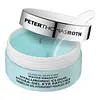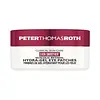What's inside
What's inside
 Key Ingredients
Key Ingredients

 Benefits
Benefits

 Concerns
Concerns

 Ingredients Side-by-side
Ingredients Side-by-side

Water
Skin ConditioningGlycerin
HumectantButylene Glycol
HumectantSodium Hyaluronate
HumectantHydrolyzed Collagen
EmollientCaffeine
Skin ConditioningCeramide NP
Skin ConditioningArnica Montana Flower Extract
MaskingAlthaea Officinalis Root Extract
Skin ConditioningAllantoin
Skin ConditioningTocopherol
AntioxidantHydrolyzed Sodium Hyaluronate
Skin ConditioningButyrospermum Parkii Butter
Skin ConditioningGlycyrrhiza Glabra Root Extract
BleachingScutellaria Baicalensis Root Extract
AstringentAngelica Gigas Root Extract
Skin ConditioningCimicifuga Racemosa Root Extract
AntimicrobialMorus Alba Bark Extract
Skin ConditioningPaeonia Lactiflora Root Extract
Skin ConditioningPhellinus Linteus Extract
Skin ConditioningPolygonum Multiflorum Root Extract
Skin ConditioningSesamum Indicum Seed Extract
Skin ConditioningSophora Angustifolia Root Extract
Skin ConditioningAloe Barbadensis Leaf Juice
Skin ConditioningRicinus Communis Seed Oil
MaskingAmorphophallus Konjac Root Powder
AbrasiveCarrageenan
Hydroxyacetophenone
AntioxidantHexylene Glycol
EmulsifyingPropanediol
SolventXylitylglucoside
HumectantSucrose
HumectantAnhydroxylitol
HumectantGlyceryl Caprylate
EmollientXylitol
HumectantBetaine
HumectantEthylhexylglycerin
Skin ConditioningGlucose
HumectantLecithin
EmollientMaltodextrin
AbsorbentMagnesium Aspartate
Skin ConditioningZinc Gluconate
Skin ConditioningAluminum Hydroxide
EmollientCopper Gluconate
Skin ConditioningPEG-60 Hydrogenated Castor Oil
EmulsifyingGellan Gum
Cyamopsis Tetragonoloba Gum
Emulsion StabilisingCeratonia Siliqua Gum
EmollientCalcium Chloride
AstringentTin Oxide
AbrasiveSynthetic Fluorphlogopite
Bis(Glycidoxyphenyl)Propane/Bisaminomethylnorbornane Copolymer
Caprylhydroxamic Acid
Disodium EDTA
1,2-Hexanediol
Skin ConditioningEthyl Hexanediol
SolventChlorphenesin
AntimicrobialPhenoxyethanol
PreservativeMica
Cosmetic ColorantCI 42090
Cosmetic ColorantCI 77891
Cosmetic ColorantCI 77491
Cosmetic ColorantWater, Glycerin, Butylene Glycol, Sodium Hyaluronate, Hydrolyzed Collagen, Caffeine, Ceramide NP, Arnica Montana Flower Extract, Althaea Officinalis Root Extract, Allantoin, Tocopherol, Hydrolyzed Sodium Hyaluronate, Butyrospermum Parkii Butter, Glycyrrhiza Glabra Root Extract, Scutellaria Baicalensis Root Extract, Angelica Gigas Root Extract, Cimicifuga Racemosa Root Extract, Morus Alba Bark Extract, Paeonia Lactiflora Root Extract, Phellinus Linteus Extract, Polygonum Multiflorum Root Extract, Sesamum Indicum Seed Extract, Sophora Angustifolia Root Extract, Aloe Barbadensis Leaf Juice, Ricinus Communis Seed Oil, Amorphophallus Konjac Root Powder, Carrageenan, Hydroxyacetophenone, Hexylene Glycol, Propanediol, Xylitylglucoside, Sucrose, Anhydroxylitol, Glyceryl Caprylate, Xylitol, Betaine, Ethylhexylglycerin, Glucose, Lecithin, Maltodextrin, Magnesium Aspartate, Zinc Gluconate, Aluminum Hydroxide, Copper Gluconate, PEG-60 Hydrogenated Castor Oil, Gellan Gum, Cyamopsis Tetragonoloba Gum, Ceratonia Siliqua Gum, Calcium Chloride, Tin Oxide, Synthetic Fluorphlogopite, Bis(Glycidoxyphenyl)Propane/Bisaminomethylnorbornane Copolymer, Caprylhydroxamic Acid, Disodium EDTA, 1,2-Hexanediol, Ethyl Hexanediol, Chlorphenesin, Phenoxyethanol, Mica, CI 42090, CI 77891, CI 77491
Water
Skin ConditioningGlycerin
HumectantChondrus Crispus Powder
AbrasiveArginine
MaskingGlycolic Acid
BufferingRetinol
Skin ConditioningCaffeine
Skin ConditioningNiacinamide
SmoothingLactobacillus Ferment Lysate
Skin ConditioningCamellia Sinensis Leaf Extract
AntimicrobialPunica Granatum Extract
AstringentAdenosine
Skin ConditioningButyrospermum Parkii Butter
Skin ConditioningTocopheryl Acetate
AntioxidantPersea Gratissima Oil
Skin ConditioningLecithin
EmollientLactobacillus Ferment
Skin ConditioningAllantoin
Skin ConditioningSodium Hyaluronate
HumectantTocopherol
AntioxidantCeratonia Siliqua Gum
EmollientChondrus Crispus Extract
Skin ConditioningXanthan Gum
EmulsifyingChlorphenesin
AntimicrobialPotassium Chloride
Polyglyceryl-10 Laurate
Skin ConditioningDextrin
AbsorbentPolyglyceryl-10 Myristate
Skin ConditioningCI 77491
Cosmetic ColorantDisodium EDTA
Synthetic Fluorphlogopite
Silica
AbrasiveCI 77007
Cosmetic ColorantButylene Glycol
HumectantPentylene Glycol
Skin ConditioningAlcohol
AntimicrobialTin Oxide
AbrasivePolysorbate 20
EmulsifyingPotassium Phosphate
BufferingCI 77891
Cosmetic ColorantPhenoxyethanol
PreservativeWater, Glycerin, Chondrus Crispus Powder, Arginine, Glycolic Acid, Retinol, Caffeine, Niacinamide, Lactobacillus Ferment Lysate, Camellia Sinensis Leaf Extract, Punica Granatum Extract, Adenosine, Butyrospermum Parkii Butter, Tocopheryl Acetate, Persea Gratissima Oil, Lecithin, Lactobacillus Ferment, Allantoin, Sodium Hyaluronate, Tocopherol, Ceratonia Siliqua Gum, Chondrus Crispus Extract, Xanthan Gum, Chlorphenesin, Potassium Chloride, Polyglyceryl-10 Laurate, Dextrin, Polyglyceryl-10 Myristate, CI 77491, Disodium EDTA, Synthetic Fluorphlogopite, Silica, CI 77007, Butylene Glycol, Pentylene Glycol, Alcohol, Tin Oxide, Polysorbate 20, Potassium Phosphate, CI 77891, Phenoxyethanol
 Reviews
Reviews

Ingredients Explained
These ingredients are found in both products.
Ingredients higher up in an ingredient list are typically present in a larger amount.
Allantoin is a soothing ingredient known for its protective and moisturizingg properties. Because of this, it is often added to products with strong active ingredients.
Studies show higher concentrations of this ingredient can promote wound healing.
Though it can be derived from the comfrey plant, allantoin is produced synthetically for cosmetic products to ensure purity.
Learn more about AllantoinButylene Glycol (or BG) is used within cosmetic products for a few different reasons:
Overall, Butylene Glycol is a safe and well-rounded ingredient that works well with other ingredients.
Though this ingredient works well with most skin types, some people with sensitive skin may experience a reaction such as allergic rashes, closed comedones, or itchiness.
Learn more about Butylene GlycolThis ingredient is also known as shea butter. It is an effective skin hydrator and emollient.
Emollients help soothe and soften your skin. It does this by creating a protective film on your skin. This barrier helps trap moisture and keeps your skin hydrated. Emollients may be effective at treating dry or itchy skin.
Shea butter is rich in antioxidants. Antioxidants help fight free-radicals, or molecules that may harm the body. It is also full of fatty acids including stearic acid and linoleic acid. These acids help replenish the skin and keep skin moisturized.
While Shea Butter has an SPF rating of about 3-4, it is not a sunscreen replacement.
Shea butter may not be fungal acne safe. We recommend speaking with a professional if you have any concerns.
Learn more about Butyrospermum Parkii ButterCaffeine is most associated with coffee, tea, and cacao. In skincare, it helps with calming inflammation and is rich in antioxidants.
While caffeine is used to treat cellulite and and dark circles, further studies are needed to prove this. It has been believed to help with these skin conditions due to its ability to dilate blood vessels and increase blood flow.
Some studies are looking into caffeine's ability to protect against UV rays.
Learn more about CaffeineCeratonia Siliqua Gum is extracted from the seeds of the carob tree. You might know this ingredient as Carob Gum or Locust Bean Gum. It is used to stabilize other ingredients and improve the texture of products.
Carob gum is made up of long-chain polysaccharides. This makes it a natural thickener.
Yes! This ingredient comes from the seeds of a tree. The name 'Locust Bean Gum' can be misleading.
Learn more about Ceratonia Siliqua GumChlorphenesin is a synthetic preservative. It helps protect a product against bacteria in order to extend shelf life. In most cases, Chlorphenesin is paired with other preservatives such as phenoxyethanol and caprylyl glycol.
Chlorphenesin is a biocide. This means it is able to help fight the microorganisms on our skin. It is also able to fight odor-releasing bacteria.
Chlorphenesin is soluble in both water and glycerin.
Studies show Chlorphenesin is easily absorbed by our skin. You should speak with a skincare professional if you have concerns about using Chlorphenesin.
Learn more about ChlorphenesinCi 77491 is also hydrated iron III oxide. It's sole purpose is to give a red/pink hue to products.
Iron III oxides are classified as inorganic chemicals for coloring.
Synthetically created Ci 77491 is considered safer than those naturally found. This is because the synthetically created version may contain less impurities. Iron oxides are generally non-toxic and non-allergenic.
Learn more about CI 77491Ci 77891 is a white pigment from Titanium dioxide. It is naturally found in minerals such as rutile and ilmenite.
It's main function is to add a white color to cosmetics. It can also be mixed with other colors to create different shades.
Ci 77891 is commonly found in sunscreens due to its ability to block UV rays.
Learn more about CI 77891Disodium EDTA plays a role in making products more stable by aiding other preservatives.
It is a chelating agent, meaning it neutralizes metal ions that may be found in a product.
Disodium EDTA is a salt of edetic acid and is found to be safe in cosmetic ingredients.
Learn more about Disodium EDTAGlycerin is already naturally found in your skin. It helps moisturize and protect your skin.
A study from 2016 found glycerin to be more effective as a humectant than AHAs and hyaluronic acid.
As a humectant, it helps the skin stay hydrated by pulling moisture to your skin. The low molecular weight of glycerin allows it to pull moisture into the deeper layers of your skin.
Hydrated skin improves your skin barrier; Your skin barrier helps protect against irritants and bacteria.
Glycerin has also been found to have antimicrobial and antiviral properties. Due to these properties, glycerin is often used in wound and burn treatments.
In cosmetics, glycerin is usually derived from plants such as soybean or palm. However, it can also be sourced from animals, such as tallow or animal fat.
This ingredient is organic, colorless, odorless, and non-toxic.
Glycerin is the name for this ingredient in American English. British English uses Glycerol/Glycerine.
Learn more about GlycerinLecithin is a term for a group of substances found in the cell membranes of plants, animals, and humans. They are made up of mixture of phospholipids.
This ingredient has emollient and emulsifying properties.
As an emollient, lecithen helps soften the skin and creates a barrier to keep moisture in.
As an emulsifier, it also helps prevent water and oil ingredients from separating. Lecithin can also help ingredients be better absorbed by the skin.
This is because the phospholipids in lecithin produce liposomes. Liposomes help other ingredients get through the skin barrier.
Depending on the source of this ingredient, lecithin may not be fungal acne safe. This is because some sources of lecithin come from soybean oil, which may feed the malassezia yeast that feeds fungal acne.
We recommend reaching out to the brand you are purchasing from to inquire about the source of their lecithin.
Some other names for this ingredient include soy lecithin and deoiled soy lecithin.
Learn more about LecithinPhenoxyethanol is a preservative that has germicide, antimicrobial, and aromatic properties. Studies show that phenoxyethanol can prevent microbial growth. By itself, it has a scent that is similar to that of a rose.
It's often used in formulations along with Caprylyl Glycol to preserve the shelf life of products.
Sodium Hyaluronate is hyaluronic acid's salt form. It is commonly derived from the sodium salt of hyaluronic acid.
Like hyaluronic acid, it is great at holding water and acts as a humectant. This makes it a great skin hydrating ingredient.
Sodium Hyaluronate is naturally occurring in our bodies and is mostly found in eye fluid and joints.
These are some other common types of Hyaluronic Acid:
Learn more about Sodium HyaluronateSynthetic Fluorphlogopite is the synthethic version of mica. It consists of fluorine, aluminum and silicate.
Synthetic Fluorphlogopite is used to add volume to products.
It is considered non-irritating on the skin.
Learn more about Synthetic FluorphlogopiteTin Oxide is an inorganic oxide used to add opacity and volume to a product. In nature, it is already found in mineral form. The main ore of tin is an opaque and shiny mineral called casseterite.
Tin Oxide helps remove translucency in a product, or make it more opaque. Besides adding opacity, tin oxide is used for bulking to add volume.
Tocopherol (also known as Vitamin E) is a common antioxidant used to help protect the skin from free-radicals and strengthen the skin barrier. It's also fat soluble - this means our skin is great at absorbing it.
Vitamin E also helps keep your natural skin lipids healthy. Your lipid skin barrier naturally consists of lipids, ceramides, and fatty acids. Vitamin E offers extra protection for your skin’s lipid barrier, keeping your skin healthy and nourished.
Another benefit is a bit of UV protection. Vitamin E helps reduce the damage caused by UVB rays. (It should not replace your sunscreen). Combining it with Vitamin C can decrease sunburned cells and hyperpigmentation after UV exposure.
You might have noticed Vitamin E + C often paired together. This is because it is great at stabilizing Vitamin C. Using the two together helps increase the effectiveness of both ingredients.
There are often claims that Vitamin E can reduce/prevent scarring, but these claims haven't been confirmed by scientific research.
Learn more about TocopherolWater. It's the most common cosmetic ingredient of all. You'll usually see it at the top of ingredient lists, meaning that it makes up the largest part of the product.
So why is it so popular? Water most often acts as a solvent - this means that it helps dissolve other ingredients into the formulation.
You'll also recognize water as that liquid we all need to stay alive. If you see this, drink a glass of water. Stay hydrated!
Learn more about Water